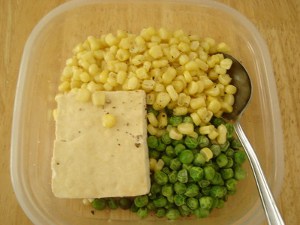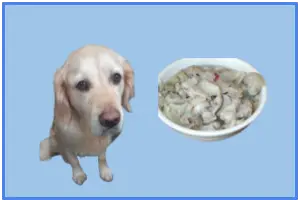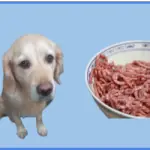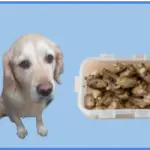
You will be pleased to know that dogs can safely eat peas and corn either as a snack or as a garnish in their main meal.
Peas shouldn’t be fed to any dog with kidney disease- for reasons that I explain later.
But for every other dog, these two vegetables are in the clear.
They will provide your dog with a boost of minerals and vitamins and with a chance to eat foods with different textures.
And the nutrition in peas is simply amazing- it was a pleasant surprise to me and I’m sure that it will be for you.
And in the next section, I spell out just how amazing peas are!
How healthy are peas?
Over the past few weeks, I have looked at lots of nutrition data for vegetables- green beans, broccoli, celery and even cauliflower leaves…
If that makes me a bit weird- so be it!
But what it does mean is that I can spot an impressive stat when I see one.
And what leaps out at me from peas is how much fibre they contain.
And as a man who has written an article on pumpkin and diarrhea, I know a thing or two about fibre!
Just so you know nearly 6% of a pea is fiber.
Other nutritional highlights from a pea, include that it is over 5% protein and that it is a rich source of some crucial B vitamins- B3 (niacin), B1 (thiamin) and B6.
Now, as a family, B vitamins are very powerful and are known to be involved with a huge range of functions from energy levels to the growth of red blood cells.
But, it doesn’t end there: peas just keep on giving!
They are a great source of vitamin A which helps your dog’s eyesight and will provide your dog with an extra boost of vitamin K (a vitamin that dogs create for themselves) but the odd boost or two won’t do any harm.
In terms of minerals, peas contain lots of copper (those red blood cells again), manganese (it plays a role in blood clotting and reducing inflammation) and phosphorus (needed for healthy teeth and bones.)
So I guess the next question is, should I feed my dog, cooked, frozen or raw peas?
Cooked green peas vs frozen peas vs raw green peas
Now there is very little difference in the nutritional value of all of these different forms of peas.
To make it easier, I have put the most important numbers in a table below.
| 100 g serving | Raw | Frozen | Boiled |
| Calories | 81 | 77 | 84 |
| Dietary Fibre | 5.7% | 4.5% | 5.5% |
| Sugar | 5.7 % | 5% | 5.9% |
| Protein | 5.4% | 5.2% | 5.4% |
| Vitamin B3 | 2.090 mg | 1.723 mg | 2.021 mg |
| Vitamin A | 765.00 IU | 2058 IU | 801 IU |
| Vitamin C | 40 mg | 18 mg | 14.2 mg |
| Vitamin K | 24.8 mcg | 27.9 mcg | 25.9 mcg |
| Copper | .176 mg | .124 mg | .173 mg |
Mostly these numbers show how nutritious peas are whether they are eaten raw, frozen or cooked.
Some of the biggest differences are in how much more vitamin A frozen peas contain compared to raw or cooked peas.
Or how much more vitamin C raw peas contain compared to their frozen or cooked “colleagues”!
And before you get all excited, there is nothing wrong with feeding your dog frozen peas and here is an article to prove it!
This is good news when it comes to preparation because anything that doesn’t involve cooking speeds up the process.
Now the eagle eyed amongst will have noted that, as yet, I haven’t mentioned canned peas.
And the reason for that is that I didn’t want too many columns in my table.
Canned peas are fine to feed to your dog- just try and buy the cans that don’t have any added salt.
Because the cans that do use added salt will have sodium levels that are through the roof!
Are there any risks from eating peas?
The good news couldn’t go on forever, could it?
Peas pose a fake risk and a real risk.
Firstly the fake risk.
Well, it isn’t really a fake risk but it is one to be aware of.
Fed to the wrong dog, peas can be a choking hazard.
You know, for those dogs that don’t like to chew their food.
On a more serious note, peas do pose a serious risk to some dogs- those with kidney disease.
And the reason for this is that peas contain purines, which is a compound found in many foods.
The trouble for any dog with weak kidneys is that purines turn into uric acid which would be a real problem.
Since I have run out of things to say in terms of dogs and peas, I will move on and talk about corn
How healthy is corn?
Having looked at the data, I’m not impressed by corn as much as I am by peas.
It has about the same amount of calories but slightly more carbohydrates than peas.
Within the carbohydrates, it has less fibre than peas and more sugar.
It also contains less protein.
And, after the huge multi vitamin boost that peas can provide, relatively corn is a bit of a disappointment.
Let’s take a look.
| 100 g serving | Peas | Sweetcorn |
| Calories | 81 | 86 |
| Dietary Fibre | 5.7% | 2% |
| Sugar | 5.7 % | 6.3% |
| Protein | 5.4% | 3.3% |
| Vitamin B3 | 2.090 mg | 1.77 mg |
| Vitamin A | 765.00 IU | 187 IU |
| Vitamin C | 40 mg | 6.8 mg |
| Vitamin K | 24.8 mcg | .3 mcg |
| Copper | .176 mg | .054 mg |
Calorie wise, per serving these two vegetables are about the same.
But there is a huge difference in the amount of fibre and peas are well on top (5.7% vs 2 %.)
And peas have more protein in them.
And as we move down the list a similar story continues.
Peas come out on top- in fact as we explore more nutrients, the gap between the two seems to increase.
I mean, look at the difference of the levels of vitamin A, vitamin C or vitamin K in these two vegetables.
Relatively speaking, the gaps are huge.
And this chart isn’t only showing nutrients where peas come out on top.
I have tried to find a vitamin or mineral which is in greater abundance in corn than peas, but I can’t!
In the next section I want to look at how corn should be prepared for your dog?
Cooked sweetcorn vs frozen corn vs raw sweetcorn
When we look at the nutrition that cooked sweetcorn provides compared to frozen or raw corn, it is much like peas.
There is very little difference between them.
And I’m not going to do any comparison tables as far as sweetcorn is concerned.
Which means that you can feed corn to your dog in one way or a variety of ways, guilt free.
Like green peas, frozen might be a great addition to your dog’s water bowl in summer.
And if you are going to cook your sweetcorn, the quickest and easiest method is to steam it.
Just avoid adding any butter because that will spoil the “health factor”.
Risk from corn?
I think that the only risk of feeding corn to your dog is if you feed it to your dog whilst it is still “on the cob”.
If your dog tried to eat the cob, they could be at risk of choking themselves or blocking part of their GI tract.
Besides, the husk has the same texture and nutritional value as a pair of old boots.
So please, only feed corn that has been taken off the husk to your dog!
Should puppies eat peas and corn?
There is no reason why an older puppy shouldn’t have a combination of peas and corn added to their diet.
Whereas I dismissed the risk of dogs choking on peas, I think that the risk to puppies with peas and corn is greater.
So introduce smaller amounts at first and just keep an eye on them as they eat it.
Then once you know that they love it and that by eating it they don’t have a coughing fit, bingo you have found a new vegetable combination to spice up their dinner time!
What other combinations of vegetables are good for my dog?
I guess after my drubbing of corn you might be looking for another vegetable to pair with peas in your dog’s bowl?
I wasn’t trying to put a downer on corn- I’m a keen fan of it myself, it’s just that it looks a little sorry for itself when compared to the mighty pea!
To be honest I’m not sure that many vegetables compare favourably to the pea.
I think the first place to look for all of us is our fridge.
What other vegetables do you have at home?
If you can feed your dog vegetables that you regularly eat yourself, it just makes things easier.
Carrots are a great favourite, as a snack or as an add in to their main meal.
Another handy hint when you’re thinking about adding a mix of vegetables in your dogs meals is to avoid using vegetables that are the same colour together.
This is because vegetables that are similar colours often have the same mix of vitamins and minerals.
For instance, carrots and pumpkin are high in vitamin A.
Broccoli and kale have lots of iron and calcium in them.
If you can combine vegetables that are different colours it will help to give your dog a variety of different vitamins and minerals instead of giving them an “overdose” of just a few…
How many peas and corn should I feed my dog?
It might seem cruel but any time that you add extra food into your dog’s diet, it should only add up to a maximum of 10% of the total amount of food that your dog consumes in a day.
So my Golden Retrievers eat about 500 g of food per day and so if I was to feed them a portion of peas and corn, it should not exceed more than 50 g.
To make it easier that is between three and four tablespoons.
So now that we have an ideal amount worked out, the next puzzle is how often?
How often should I feed dogs peas and corn?
I don’t think that there is anything wrong with adding one or two vegetables to your dog’s food everyday.
But I do think that there is something wrong with a dog that only eats peas and corn with their food for the rest of their lives.
If you can manage it (it is extra work) then mix some veg in with your dog’s food everything but just mix it up a bit.
And I don’t mean that a dog should get a different vegetable everyday, just that over a couple of weeks or a month that get to eat a few different varieties of vegetables.
If for some reason you have lots of peas or corn available then add them to your dog’s food for a week or two.
As long as after that your dog gets to experience something else.
Partly it is about nutrition (your dog ingests a range of vitamins and minerals) but different vegetables have different textures.






